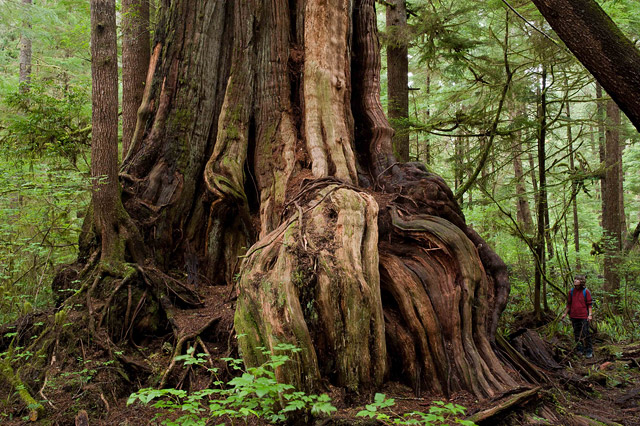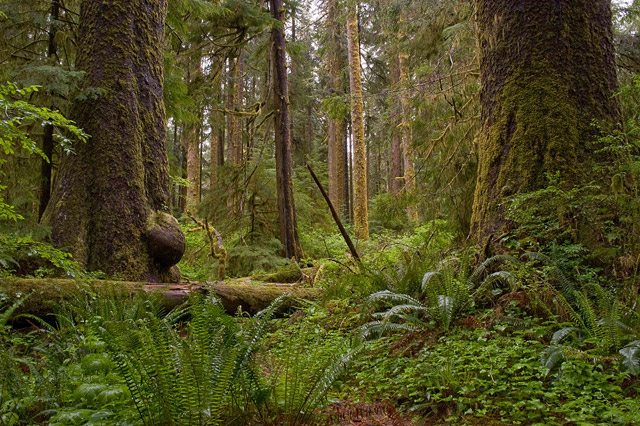| |
| Bereits zum 31. März 2014 hätte die komplette Umsetzung der Ziele des Great Bear Rainforest-Abkommens und vor allem die volle Implementierung der Holzeinschlagsregeln nach dem sogenannten Ecosystem-Based Management (EBM) erfolgen sollen, so wie es der Zeitplan des Great Bear Rainforest-Abkommens von 2006 vorsah. Doch jetzt muss das Joint Solutions Project (JSP) mit den beteiligten Umweltschutzgruppen Greenpeace Canada, Forest Ethics und Sierra Club BC einräumen, dass es mindestens bis Ende 2014 dauern wird, bis es soweit sein wird. Immerhin haben sowohl die Provinzregierung von BC als auch die am Abkommen beteiligten First Nations in einem Brief an das JSP zugesagt, nach wie vor an den ausgehandelten Zielen festzuhalten. |
| Nachfolgend ist die Presseerklärung des JSP vom 31. März 2014 – dem eigentlich vorgesehenen Umsetzungstag für das Great Bear Rainforest-Abkommen – mit dem Titel „Environmental organizations welcome Province and First Nations commitments to finalize conservation and human well being steps in the Great Bear Rainforest in 2014“ wiedergegeben: |
| „Greenpeace, ForestEthics Solutions and Sierra Club B.C. welcome the commitments received by letter today from the B.C. government and First Nations organizations – Great Bear Initiative and Nanwakolas Council – to deliver the remaining measures required for the final implementation of the Great Bear Rainforest Agreements by the end of 2014. The groups acknowledge the extension of the implementation process by several months from the March 31, 2014 date, announced in 2009, but anticipate that all parties will make fulfilling the commitments a high priority. ‚The Great Bear Rainforest is a globally outstanding region. Considering the complexity of the work involved we understand that a certain amount of additional time is needed to properly finish what we all started years ago. Today’s letter is welcome, with solid commitments to prioritize completion by year’s end‘, said Eduardo Sousa, senior forest campaigner for Greenpeace Canada. ‚Government leadership in completing the outstanding steps as soon as possible will be critically important to achieve the goal of ecological integrity without undermining habitat values for species like Grizzly Bear, Marbled Murrelet, Tailed Frog, Mountain Goat and Northern Goshawk.‘, said Jens Wieting, Forest and Climate Campaigner with Sierra Club BC. ‚Eight years ago today B.C. secured a peace in these woods by committing to preserve the ecological health of the forests and improve the well being of the communities. Today we are in the homestretch, with commitments to complete this landmark conservation project in 2014. We believe this is important to communities, industry, markets, and our organizations alike‘, said Valerie Langer with ForestEthics Solutions. ‚Our organizations remain fully committed to seeing this through in 2014.‘ |
| The BC government and the region’s First Nations committed to a number of actions that they will undertake collaboratively over the course of the following months to meet the goals of the Agreements in achieving low ecological risk and high levels of human well-being by the end of 2014: |
- Amended draft legal logging rules which increase conservation of the rainforest by approximately 500,000 hectares, out for public comment period by September, and legislated by December
- A package of additional human well-being initiatives for First Nations communities by December
- Financial support for mapping new conservation methodology on the ground in three pilot areas …“
|
 |
Uralter Riesenlebensbaum (Western Redcedar, Thuja plicata)
im pazifischen Küstenregenwald |
© Klaus Pommerenke |
|
| |
| Im Greenpeace-Bericht „Forest Solutions. An insider’s look at Greenpeace collaborations in forest regions around the world“ wird das Great Bear Rainforest-Abkommen – obwohl noch nicht komplett umgesetzt – als eines jener „Forest Solutions“-Projekte gepriesen, „that can be carried into other forest regions globally“. Eduardo Sousa, Senior Forest Campaigner von Greenpeace Canada, schrieb in seinem Artikel „Of Solutions and Commitments: Going the distance in the Great Bear Rainforest“ vom 22. April 2014: „We are close though in realizing (at least) the conservation goal. Earlier this year we and our allies (Sierra Club BC and ForestEthics Solutions) reached a set of recommendations with industry on how to achieve low ecological risk while allowing for a viable commercial forest industry. This was provided to First Nations governments and the BC Government in their Government-to-Government deliberations. Governments responded last week on March 31 to our recommendations with a letter committing to best efforts to examine and implement the recommendations to reach both goals of the Agreements by the end of this year, and we welcomed this solid commitment. March 31 is a significant date for many of us that have sought to successfully implement the Great Bear Rainforest Agreements. The ambitious Agreements first announced to the world in 2006 aimed for completion by March 31, 2009. On that date in 2009, we didn’t reach our goal but rather succeeded in having 50 % of old-growth ecosystems set aside from logging, with a five-year extension on developing a plan to get to 70 %, and further commitments to improve well-being in First Nations communities. March 31, 2014 – five years to the day – has come and gone. We still haven’t reached the 2 goals and this underscores how complex the planning and related issues have been, and continue to be. However given that we and our allies did reach a set of recommendations to get to low risk (the ultimate goal), coupled with the letter of commitments from First Nations governments (represented by Nanwakolas Council, Coastal First Nations–Great Bear Initiative) and the BC Government, we have moved significantly further ahead to the degree that we expect to finish by the end of the year.“ |
| |
 |
| Sitka-Fichten (Sitka Spruce, Picea sitchensis). Sie werden im Küstenregenwald über 1.000 Jahre alt und wachsen bis zu 95 m hoch |
© Klaus Pommerenke |
|
| |
| Jens Wieting, Forest and Climate Campaigner von Sierra Club BC, beschrieb in seinem Artikel „Great Bear Rainforest Will Win With Extra Time“ in der Huffington Post vom 15. April auch die Probleme bei der Umsetzung des Great Bear Rainforest-Abkommens, v. a. die Probleme mit dem Forstkonzern TimberWest, der nach wie vor an der herkömmlichen Kahlschlags-Forstwirtschaft festhält und sich nicht an die rechtsverbindlich vereinbarten Regeln des EBM halten will: |
| „As of March 31, 2014, the milestone date agreed on five years ago, it’s clear that the final steps of the Great Bear Rainforest Agreements for healthy rainforest and healthy communities will take several months longer than originally planned. |
| The good news is that the government of British Columbia and First Nations have renewed their commitment to finish the task by the end of 2014 in a letter to Sierra Club BC and our partners. Another reassuring factor is that the extra time will not change the fact that everybody wins, once the remaining measures are taken by the end of the year (with one possible exception, more on that later). |
| The Great Bear Rainforest is world-renowned for its spectacular natural ecosystems, home of First Nations cultures and the inspiring story of moving from conflict to solutions for conservation and community well-being. These are reflected in the Great Bear Rainforest Agreements announced in 2006 by the B.C. government, First Nations, a group of forestry companies and a coalition of environmental groups (Sierra Club BC, Greenpeace, ForestEthics Solutions), after years of confrontation, then negotiations and a lot of good will by all parties involved. |
| On March 31, 2009, a number of key milestones were met: half of the region’s rainforest was set aside through a combination of new protected areas and stricter logging regulation; $120 million funding was made available for First Nation communities to support a conservation economy; and a new government-to-government relationship between the Province and First Nations got established. Next steps to meet the goals of ecological integrity and human well-being were determined in a five year work plan to be delivered by March 31, 2014. |
| The Great Bear Rainforest Agreements are guided by the Ecosystem-Based Management Handbook, a set of expert recommendations for the region on how to achieve both low ecological risk for the rainforest, and ensure a high quality of life in coastal communities without undermining the environment. One of the key recommendations on the conservation side was to set aside 70 per cent of the natural level of old-growth forests, across all types of ecosystems. The 2009 measures fell 20 per cent short of that. |
| In January, after three more years of technical work, negotiations and planning, the environmental organizations and a group of forest companies who together form the Joint Solutions Project (JSP) delivered a set of recommendations outlining increased conservation to close this gap, and the future scope of logging. The proposal would see an additional 500,000 hectares of forest set aside to achieve the goal of low ecological risk and result in a harvest level that can still maintain commercial forestry. |
| The province and the region’s First Nations are now in the process of reviewing the proposal, while simultaneously identifying additional measures to support communities with new training, jobs and revenue opportunities. Their work plan is forecasting draft amendments to logging regulations out for a 60-day public comment period by September and final implementation by December. |
| Taking this additional time is defensible considering the complexity of the work required to properly finish the long term framework for a region larger than Switzerland. That said, delivery this year is critically important because the world is watching the Great Bear Rainforest Agreements and has been waiting for the final outcome for many years now. |
| Some milestones were not met in 2009 and instead included in a five-year work plan. Internationally, environmental organizations, customers of wood products and other stakeholders interested in conservation and sustainable forest management are expecting success in 2014. Timely implementation will be essential for many observers in assessing whether the Great Bear Rainforest Agreements can stand the test of a world-class conservation model that others can learn from. |
| But there is another reason why we cannot afford to take much longer to increase conservation and tighten the rules. One major logging company operating in the region is not a member of the Joint Solutions Project (BC Timber Sales, Catalyst Paper Corporation, Howe Sound Pulp & Paper, Interfor and Western Forest Products are members). Instead, TimberWest has a long history of opposing increases in conservation and undertaking extremely profit-driven logging operations in the southern-most portion of the Great Bear Rainforest with very little remaining old-growth. |
| In recent months, TimberWest has come under fire for, among other things, use of an inadequate old-growth definition. This has allowed them to develop logging plans targeting some of the very last old-growth trees by classifying blocks as second-growth forest. As in the past, the company has promised to correct some of their actions but there is an imminent threat of logging based on poor planning, targeting rainforest ecosystems at high ecological risk in the near future. |
| It is still possible for TimberWest to improve their tarnished reputation by deferring logging in critical areas to allow enough time for careful planning with independent experts before resuming operations. But based on their record, there is too much at stake for the entire model and the ecological integrity in landscapes, which are already at the brink ecologically, to hope for this outcome. Full implementation of the outstanding conservation steps is the only guarantee to close the loopholes they are taking advantage of as soon as possible. |
| Implementation of the Great Bear Rainforest Agreements this year will be worth celebrating because it will bring certainty for ecosystems and forestry jobs, new initiatives for community well-being, and much needed hope that solutions for a better world are possible.“ |
| |
 zurück zurück |

